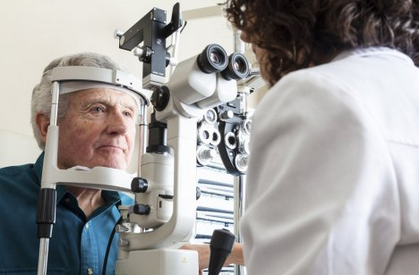
Compound Restores Transparency to Mouse Lenses, Human Lens Tissue
By Peter Farley via UCSF.edu
A chemical that could potentially be used in eye drops to reverse cataracts, the leading cause of blindness, has been identified by a team of scientists from UC San Francisco (UCSF), the University of Michigan (U-M), and Washington University in St. Louis (WUSTL).
Identified as a “priority eye disease” by the World Health Organization, cataracts — caused when the lenses of the eyes lose their transparency — affect more than 20 million people worldwide. Although cataracts can be successfully removed with surgery, this approach is expensive, and most individuals blinded by severe cataracts in developing countries go untreated.
Reported Nov. 5 in Science, the newly identified compound is the first that is soluble enough to potentially form the basis of a practical eye-drop medication for cataracts.
Cataracts are primarily a disease of aging. As is seen in neurodegenerative conditions such as Alzheimer’s disease and Parkinson’s disease, a hallmark of the condition is the misfolding and clumping together of crucial proteins. In the case of cataracts, the affected proteins are known as crystallins.
Crystallins are the major component of fiber cells, which form the eyes’ lenses, and the unique properties of these cells make them particularly susceptible to damage, said Jason Gestwicki, PhD, associate professor of pharmaceutical chemistry at UCSF and co-senior author of a paper on the new research, most of which was undertaken in Gestwicki’s laboratory at the U-M Life Sciences Institute.

Catalyst Award winner
“Shortly after you’re born, all the fiber cells in the eye lose the ability to make new proteins, or to discard old proteins,” said Gestwicki, who has continued his work on cataracts at UCSF, where he joined the faculty about two years ago. “So the crystallins you have in your eye as an adult are the same as those you’re born with.”
In order for our lenses to function well, this permanent, finite reservoir of crystallins must maintain both the transparency of fiber cells and their flexibility, as the eyes’ muscles constantly stretch and relax the lens to allow us to focus on objects at different distances.
The crystallins accomplish these duties with the help of aptly named proteins known as chaperones, which act “kind of like antifreeze,” Gestwicki said, “keeping crystallins soluble in a delicate equilibrium that’s in place for decades and decades.”
This state-of-affairs is “delicate” because pathological, clumped-together configurations of crystallins are far more stable than properly folded, healthy forms, and fiber-cell chaperones must continually resist the strong tendency of crystallins to clump. A similar process underlies other disorders related to aging, such as Alzheimer’s disease, but in each of these diseases the specific protein that clumps together and the place in the body that clumping occurs is different. In all cases, these clumped-together proteins are called amyloids.
Application for Cataracts and Beyond
Dogs are also prone to developing cataracts. Half of all dogs have cataracts by nine years of age, and virtually all dogs develop them later in life. An effective eye-drop medication could potentially benefit about 70 million affected pet dogs in the United States.
The research on cataracts by Gestwicki and colleagues was a 2013 winner of a UCSF Catalyst Award, sponsored by the UCSF Clinical and Translational Science Institute. Catalyst's support and access to the program’s consultants led to the launch of ViewPoint Therapeutics, and a Catalyst consultant now serves as chair of ViewPoint's Board of Directors.
"This is the first project I’ve taken this far from the laboratory to the clinic," said Gestwicki. “I had some idea of the complexity and number of pieces involved in a drug discovery process but the Catalyst Awards allowed us to get quickly up to speed on the aspects of drug discovery that we were less familiar with, which was really valuable."
ViewPoint was formed through the “incubator” program of the California Institute of Quantitative Biosciences (QB3) at UCSF, and is located adjacent to the UCSF campus in QB3’s Janssen Labs.
Related Catalyst story here
